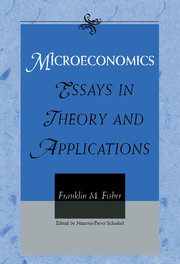Book contents
- Frontmatter
- Contents
- Introduction
- Part I Disequilibrium and Stability
- 1 The Formation of Economic Magnitudes: Disequilibrium and Stability (1990)
- 2 Quasi-Competitive Price Adjustment by Individual Firms: A Preliminary Paper (1970)
- 3 Stability and Competitive Equilibrium in Two Models of Search and Individual Price Adjustment (1973)
- 4 On Price Adjustment without an Auctioneer (1972)
- 5 Quantity Constraints, Spillovers, and the Hahn Process (1978)
- 6 On Stability Analysis with Disequilibrium Awareness (1988)
- 7 It Takes t* to Tango: Trading Coalitions with Fixed Prices (1989)
- 8 An Alternate Proof and Extension of Solow's Theorem on Nonnegative Square Matrices (1962)
- 9 Choice of Units, Column Sums, and Stability in Linear Dynamic Systems with Nonnegative Square Matrices (1965)
- 10 A Simple Proof of the Fisher–Fuller Theorem (1972)
- 11 Gross Substitutes and the Utility Function (1972)
- Part II Welfare Economics and Consumer Theory
- Part III Applications of Microeconomic Theory
- Part IV Industrial Organization, Economics, and the Law
- Part V Public Policy Applications
- Epilogue
- Indexes
2 - Quasi-Competitive Price Adjustment by Individual Firms: A Preliminary Paper (1970)
Published online by Cambridge University Press: 20 March 2010
- Frontmatter
- Contents
- Introduction
- Part I Disequilibrium and Stability
- 1 The Formation of Economic Magnitudes: Disequilibrium and Stability (1990)
- 2 Quasi-Competitive Price Adjustment by Individual Firms: A Preliminary Paper (1970)
- 3 Stability and Competitive Equilibrium in Two Models of Search and Individual Price Adjustment (1973)
- 4 On Price Adjustment without an Auctioneer (1972)
- 5 Quantity Constraints, Spillovers, and the Hahn Process (1978)
- 6 On Stability Analysis with Disequilibrium Awareness (1988)
- 7 It Takes t* to Tango: Trading Coalitions with Fixed Prices (1989)
- 8 An Alternate Proof and Extension of Solow's Theorem on Nonnegative Square Matrices (1962)
- 9 Choice of Units, Column Sums, and Stability in Linear Dynamic Systems with Nonnegative Square Matrices (1965)
- 10 A Simple Proof of the Fisher–Fuller Theorem (1972)
- 11 Gross Substitutes and the Utility Function (1972)
- Part II Welfare Economics and Consumer Theory
- Part III Applications of Microeconomic Theory
- Part IV Industrial Organization, Economics, and the Law
- Part V Public Policy Applications
- Epilogue
- Indexes
Summary
Introduction
One of the principal unfilled holes in microeconomic theory is of deep importance. We have a satisfactory theory of equilibrium in perfect competition; despite great and admirable labor by many leading theorists, we have no similarly satisfactory theory of how equilibrium is reached. Such adjustment models as have been proposed and studied generally are less than satisfactory, for they rest on assumptions (often plausible ones) about the way in which prices behave in different markets taken as a whole, rather than on a model of individual behavior. Thus, as is well known, the tâtonnement process involves the assumption that the rate of change of price is proportional to excess demand, and even the non-tâtonnement processes that have been studied incorporate a similar price adjustment mechanism while allowing trade to take place out of equilibrium. Yet, as Koopmans has pointed out, it is far from clear whose behavior is described by that price adjustment process in markets where there is in fact no auctioneer to conduct it.
The problem can be described in a related but different way. In a perfectly competitive market, all participants take price as given and believe that they cannot affect it; yet when that market is in disequilibrium, the price is supposed to move. The Invisible Hand is a little too invisible in this, the center of its activities.
- Type
- Chapter
- Information
- MicroeconomicsEssays in Theory and Applications, pp. 51 - 62Publisher: Cambridge University PressPrint publication year: 1999



